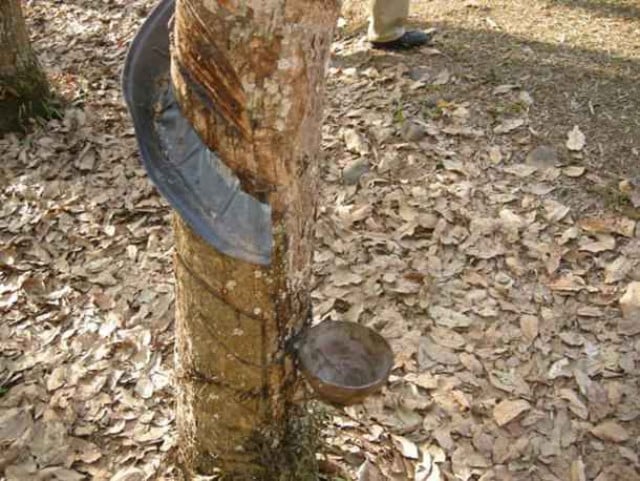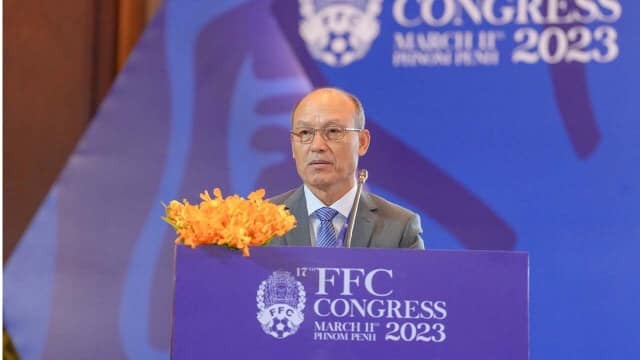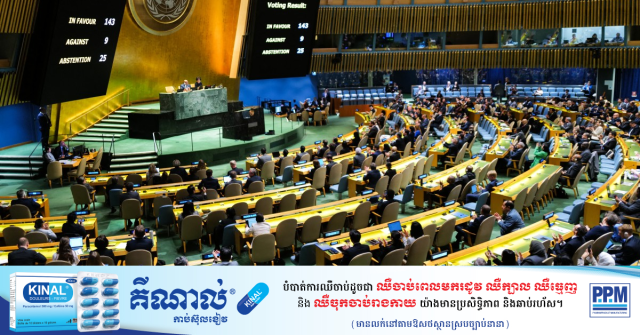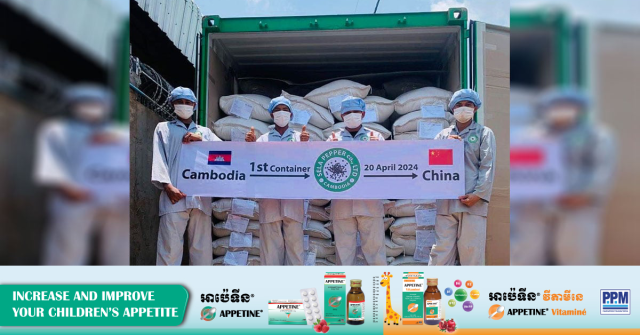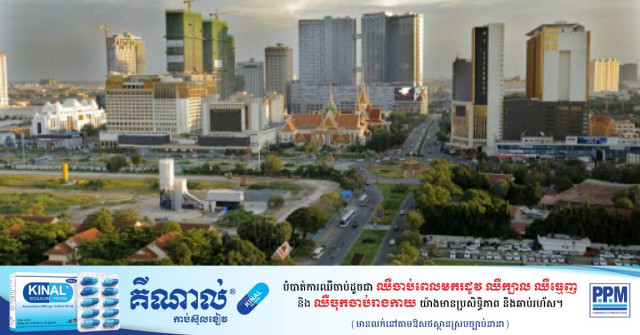Of an Unknown Village during the Khmer Rouge Years: the Story of Guoy Huy Chheng
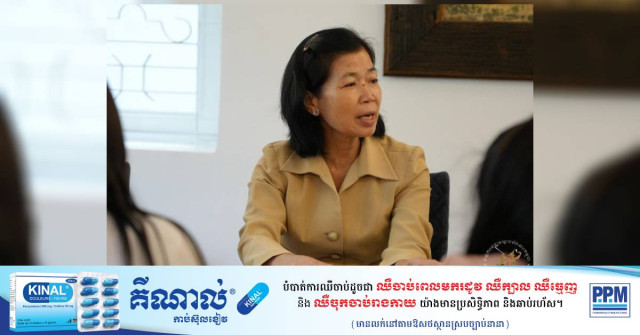
- By Lyhour Sreang
- May 3, 2024 10:50 AM
Kampuchea Krom Boulevard, Phnom Penh--On the morning of April 17, 1975, the father of Guoy Huy Chheng drove to Kampuchea Krom boulevard on a red motorcycle with his children. At one of the intersections, people young and old were cheering the soldiers in black uniforms, hoping this meant the end of the civil war. But the Khmer Rouge soldiers who had just entered Phnom Penh were not responding. They knew what was going to happen next: forced transfers.
Shortly after their arrival, hope was replaced by incomprehension and fear as people were told by the soldiers to leave their homes and walk out of the capital with whatever they could bring. They had to get away for three days or so in case, the soldiers said, Phnom Penh was bombarded by Cambodian government forces. Which did not happen.
The Khmer Rouge soldiers raised their arms and shouted at those they felt were too slow, ready as the lyrics of the Democratic Kampuchea national anthem would later state, to see “[t]he bright scarlet blood flooded over the towns and plains of our motherland Kampuchea.”
Then, a young soldier shot on the spot a man who had not followed his order. The situation was chaotic. A woman was crying, having been separated from her family.
In fear, Chheng’s father, with his children’s lives on the line, rushed with them to his stall at the Tuol Kork market where he was selling the breakfast dish kuy teav. On the way back, near the Wat Neak Voan pagoda, a man inches behind Chheng was also running. The sound of an assault rifle resonated. Chheng turned around. The man had been shot and was covered with blood.
All the roads were blocked. Most houses on the street were closed if not boarded, the entire area empty, an emptiness that Chheng could not comprehend as she was trying to cope with the killings she had just witnessed.
Before the War
Guoy Huy Chheng is of Chinese descent. Her father immigrated from the Guangdong Province in Southern China in the early 1950s. Trying to build a new life in Cambodia, he had set up a kuy teav stall in Tuol Kork on the outskirts of Phnom Penh.
In the 1960s, Prince Norodom Sihanouk, who had stepped down from the throne to enter politics as the head of his Sangkum Reastr Niyum political party, was leading the country. Which, in spite of the U.S.-Vietnam war raging along its eastern border, had become one of the most developed and modern nations in the region. However, in the midst of an economic crisis, Prince Sihanouk was voted out of power at the National Assembly in March 1970. General Lon Nol then became president of the Khmer Republic.
Having been ousted from power, Prince Sihanouk settled in Beijing and became the official head of the Khmer Rouge with the support of China and North Vietnam. On March 24, 1970, he would launch an appeal to Cambodians to join the Khmer Rouge forces and take up arms against the Cambodian government. When the Khmer Rouge seized power in 1975, he would spend the regime in his palace essentially as a prisoner, with no involvement in the government’s decisions.
As the eldest daughter of her family, Chheng was responsible for taking care of her younger siblings and assisting her parents at the stall. Every day, she had to get up at dawn to light the fire to cook the broth.
But the morning after that day of April 1975 on Kampuchea Krom Boulevard, Chheng did not prepare seasoning for the soup. She and her family got ready to leave. The noodle bowls were packed, and the chickens released from their cage so they could find their own way.
Journey along the River
Chheng’s family was ordered to head for an unknown destination. “I had to go with my family from Tuol Kork to National Road 6,” she said. “Along the main road, we met [my uncle] and his family at Prek Leap [commune].”
The eldest brother of Chheng’s father urged them to continue the journey along the river rather than heading for Battambang city as Chheng’s father had planned to do with his younger brother.
Her oldest uncle believed this to be the best way as travelling by sea and river in the past had enabled him to start a new life in Cambodia when he had travelled from mainland China. “He was right,” said Chheng. Having opted for this direction, her parents and siblings would survive the Khmer Rouge regime. Her youngest uncle and his family would be forced to go on foot and by train to Battambang province, and he would be the only one to return.
Following the advice of her oldest uncle, Chheng and her family ended up in the Khmer Rouge’s Region 505 in Kratie province. This was perhaps the most lenient region due to the way Khmer Rouge leaders in the region were applying the regime’s policies, according to researchers Sara Colm and Sorya Sim. This Northeast Zone was controlled by Secretary Ney Sarann, known as Comrade Ta Ya, until he was purged and killed in 1976. Under Ta Ya, practicing ethnic-minority religion was not forbidden, and disciplinary measures rather than executions were used against those judged wrongdoers.
At Prek Leap, Chheng’s family and her oldest uncle’s family were ordered to go to the Kratie region in the North-East Zone after they had tried not to get into a large truck meant to take people to the North-West Zone. There were many people walking on the road, Chheng recalled. “I also saw the body of a dead infant along the road,” she said.
In Kratie province, their journey took them from Prek Leap to Chi Haer village, and from Chi Haer village to Ou Reong Ov district and its subdistrict of Tuol Sophi.
Days later, they arrived in Chhloung district and stayed at that location for three months before being ordered to move to Sandan commune in Sambo district.
Chheng and her family were next ordered to walk to Sambo commune in the same district, and then return to Sandan commune, travelling each time by small narrow boats along the Mekong River in Kratie province.
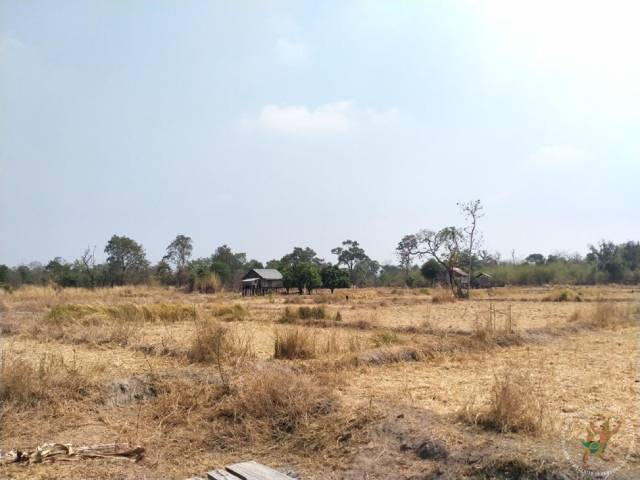 After days of travelling, Guoy Huy Chheng and her family found themselves in this region of vast fields that, as a city person, was a totally foreign environment to her. Photo: CamboCorps from Kratie
After days of travelling, Guoy Huy Chheng and her family found themselves in this region of vast fields that, as a city person, was a totally foreign environment to her. Photo: CamboCorps from Kratie
Arriving at Chang Hab
In Sandan commune, the Khmer Rouge soldiers ordered Chheng’s family and several others to get into a large truck. They eventually arrived at a village in the middle of a dense forest where a community lived. Chang Hab village in Kratie province was to be their final destination.
Known as region 505 during the Khmer Rouge years, it was around 5 kilometers from today’s National Road 7 in Sambo district’s Kbal Damrey commune.
Around 20 to 30 families lived in the village, most of them being from the ethnic minority Mel. They were defined as “base people” by the Khmer Rouge, while Chheng’s family and the others who had come from cities were labelled “new people.” The community was divided into three cooperatives, or work camps, with seven to eight families in each of them. Chheng and her family would remain in this village until the Khmer Rouge were ousted from power in January 1979.
The Mel People and the Newcomers
According to the Khmer dictionary of 1967, the Mel people were a minority group based in Kratie province. During the Khmer Republic of 1970-1975, the Mel men were soldiers in the Khmer Rouge forces. In 1977, a Mel man by the name of Chu Tang spoke of men from Cambodia’s Chinese and Cham minorities in the village having become Khmer Rouge soldiers.
Those minorities as well as the Mel people were ordered to only speak Khmer. People would occasionally speak other languages among themselves. But if a Khmer Rouge or local guards caught a person doing so, they would hang that person upside down, Chheng said.
The Story of Master Srun
Among the people who had arrived in the village and were of Khmer, Cham or Chinese background, there was a Chinese man who barely spoke Khmer and had been ordered to cut his beard by the man in charge of the village.
Srun had been a Taoist master at a Teochew temple of the Chinese community in Phnom Penh, Chheng said. With his long beard, he looked like a Taoist master from the mountains of southern China, she said. Srun had shared his despair with Chheng’s mother, and told her that, according to his beliefs, he would die if he cut his beard.
A day later, Master Srun was left no choice but to cut his long beard as Ta Hol, the commune chief who lived in the village, insisted that he did this per the rule of Angkar—as the Khmer Rouge called the organization leading the country—in spite of Chheng’s mother trying to explain Srun’s belief to Hol.
Master Srun passed away the day after cutting his beard. Since he had no family, Chheng said, “my family organized a small funeral tribute for him.” Master Srun, who was in his 40s when he died, had had no family, she recalled.
Mobile Unit at Chang Hab Village
In 1976 at the village, Chheng worked as a member of a mobile unit. Her daily routine consisted of starting work at 6:00 am at the camp, or in the rice fields, or pulling out seedlings and clearing the forest to expand the agricultural plots. All tools were made by the people in the community.
Some days, Chheng and the other workers would pull out seedlings at night, each person having to prepare at least 40 clutches of rice seedlings to plant in the dry season. There were many bugs, which was the reason why the Mel people smoked in order to keep them away. Having no choice, Chheng’s uncle secretly used his hair wax as bug repellent. Chheng tried to work as fast as she could since, she said, “it had to be done fast.
“It was a hard life,” she said. “However, people of Chinese background are good at adapting.” Chheng and her siblings had never worked in a rice field before, being city people who helped their parents at the family market stall.
Hardship Escalates
It was during 1978 that life became even harder.
If someone did not complete the task, workers would get nothing to eat at the camp. On one rainy day, Chheng’s sister Ah Su could not finish her work. She was pushed accidentally by a young Khmer Rouge from the top of a rice field irrigation canal.
One time, when the irrigation canal leaked, she said, “the Khmer Rouge ordered people to form a [human] barrier to stop the leak.” It was inhuman, she said. The following morning, Ah Su and the others had to fill the holes that had caused the leak.
“It was so hard,” Chheng said, “There was no choice, just work that day, eat that day.” Meals meant a bowl of rice gruel two times a day.
When she was vomiting, Chheng would do it in a hole in the ground and then, she said, “I just used the surface dirt to cover the holes.” No one wanted to be sick or seen as sick and unable to work, she said, “because no food was given to those who did not work.”
Even at night, there was still work to do. Chheng, Ah Su and other mobile-unit workers had to collect buffalo dung to be used as fertilizer. One night, Ah Su could not find dung to collect. “She looked so sad as she waited for buffalo dung,” Chheng said, knowing that there would be no rice gruel for her that night. “I really pitied her.” Ah Su was 5-to-8 years old during that period. But no matter one’s age, each person had to fill one basket. So, there was no rice gruel for Ah Su that night. She was so hungry that she was not able to sleep, she said.
Another day, Ah Su was struck by a young Khmer Rouge local guard for accidentally stepping in the paddy field as she was trying to grab a Manila tamarind (ampil tuk in Khmer), which had been inches away from her hand. In his rage, the guard broke one of the child’s bones, Chheng said.
The Mel People in Chang Hab Village
Ta Hol, the commune chief, was from the minority group Mel. The Mel people had lived in the forest according to their traditions for centuries. Their knowledge of wild plants and remedies was extensive and sophisticated, and proved essential, Chheng said, for people like her who had been relocated in their area.
The health center of Sre Sbov village in Sambo district, which was managed by the Khmer Rouge, only provided rabbit-dropping medicine mixed with honey or wild vines, and coconut juice as serum. Which is why the medicines of the Mel people that were effective proved essential at that time of scarcity.
During the sickness of her father, Chheng went to Ta Hol, the commune chief, for help. She told him about the dead bodies she had seen around the Khmer Rouge health center as people were dying due to sickness and the ineffective medicine of the Khmer Rouge.
 Travelling in the forest, Chheng became aware of mysterious happenings that only the Mel people knew to interpret and handle. Photo: CamboCorps from Kratie province
Travelling in the forest, Chheng became aware of mysterious happenings that only the Mel people knew to interpret and handle. Photo: CamboCorps from Kratie province
The Way of the Mel People
In the dictionary of Cambodia’s plants that she compiled, Cambodian botanist Dy Phon Pauline wrote that the Holarrhena pubescens, known by the Mel people and others in the region as tuk dahs khla, was used as traditional medicine. The sap of this shrub that is 4-to-12 meter tall is, she writes, “used in the treatment of conjunctivitis,” and also used in western medicine for the treatment of the digestive system. This plant is also widely used by the indigenous communities of Southeast Asia for the treatment of various ailments. As Chheng explained, the Mel knew which plants to use to treat the various ailments.
In the dense jungle, there was a tree called terminalia alata, or chhlik-nieng phaaek in Khmer. This tree was essential for the minority people. “The bark of the tree was used as seasoning for elephant meat,” Chheng recalled. This tree, which grows 8-to-20 meter tall in the forests of Cambodia, has been used as timber for construction and its bark for traditional medicine, as Dy Phon Pauline explained in her plant dictionary.
Before 1978, the Mel people were allowed to hunt like the other minorities in the Khmer Rouge region 505, which was the Kratie province area. According to Chey Sopheara, who also spent the regime in the Sambo district, new people did not have the right to go into the forest and hunt. However, hilltribe people would go and hunt, sharing the meat with others in the cooperative, as journalist Sara Colm explained.
In addition to their knowledge of medicinal plants, Chheng said, “the Mel people knew about spiritual curses and spells.” And these were no fantasy tales: They were real, she said. However, Chheng never understood why those spiritual curses and spells that she saw cast did not work against the Khmer Rouge cadre at all.
The Mel people were kind-hearted, said Chheng. They played an essential role at the time, Chheng said.
In addition to the Mel people, there were members of other hilltribe minorities in the village. One of them, by the name of Ta Ngav helped people by providing wild-plant remedies.
But the latitude given to the hilltribe and Mel people was eventually removed. When Ta Seng, a Khmer Rouge cadre from outside the village, arrived, being more authoritarian than Ta Hol, he prohibited all spiritual practices, even those of the Mel people.
Hope Remains
“What was the happiest moment during that regime?” When Chheng was asked this question, she could not come up with any. “I don’t think I had one,” she said. “Every time I saw the faces of my relatives, my eyes would fill with tears.” At times, she would not see her relatives for months.
“Sometimes I sang but [it had to be] only Khmer Rouge songs,” she said. “How many sets of clothes did the Khmer Rouge give you?” People would be given two sets of clothes per year, Chheng said. Sometimes, she had to use rice sacks to fix the holes in her clothes, she said.
Marriages in the Work Camps
During the regime, the Khmer Rouge authorities would select the future spouses and marry several couples at a time. The ceremony would consist of men and women being brought in, and the couples being declared married by the authorities.
But in Chheng’s case, it was the elders who picked her husband so she could be married for her safety. The marriage took place at a family’s home. Chheng and her husband could not communicate due to language barriers and, right after their marriage, they had to return to their respective work camps.
Chheng’s uncle had not approve of her getting married and had suggested waiting until the country was freed of the Khmer Rouge. However, she said, “the year 1979 was going to be the Year of the Goat.” Some people believe that marrying in that year might mean a failed marriage. So Chheng had insisted on marrying in 1978, she said. Still, her marriage would end with the end of the Khmer Rouge regime.
Risking a Visit
At one point, Chheng decided to take the risk of going to the work camp where her mother was, being concerned about her. Leaving one’s camp was prohibited but, with the help of Mel people, she was able to do so. This meant walking in the forest and the Mel people warned her not to speak to anyone while she did so in case it was a spirit calling.
The Mel people told her about the exact routine of the Khmer Rouge local guard. She had to cover the rooster so it would not see sunlight, and then walk without looking back until she arrived at Thma Kreae village where her mother was. Chheng did so and met her mother who was alive but emaciated due to lack of food.
On her way back, she met a woman in the forest. Although she did not believe this was a spirit, Chheng knew that this woman’s entire family had been executed by the Khmer Rouge. So she rushed back to her work camp.
The Last Khmer Rouge Trick
As the tension at the border raised between Vietnam and the Khmer Rouge forces in late 1978, there was a shortage of rice at Chheng’s commune.
The Khmer Rouge asked people what they thought about mixing corn and rice. Chheng’s father gave his opinion and ended up being “re-educated” for three days.
As the Khmer Rouge were losing ground against the Vietnamese force, those in charge of the area asked if people wanted to flee to Vietnam where some of their relatives might be. Those who said yes were killed as the Khmer Rouge moved to the northwest, Chheng said.
The Return to Phnom Penh
After the collapse of the Khmer Rouge, Chheng and her family decided to leave Chang Hab village and attempt to return to Phnom Penh. They took with them some rice that had been stored in a pagoda. “We exchanged rice for riverboat service,” Chheng said.
It has been 45 years since the Khmer Rouge were officially defeated on Jan. 7, 1979, and yet, Chheng said she still feels uneasy when she talks of that time. Like so many people who lived through the regime, both her physical and mental health were profoundly damaged.
The memories never disappear, she said. What happened in April 1975 was not a regime being ousted by the armed force of another, but a genocide that, three years and eight months later, would have caused the death of more than 2 million people.
Now in her mid-60s, Chheng suffers from serious neck problem, the result of having carried bags of salt of more than 10 kilos (around 22 pounds) on her head in the Khmer Rouge work camp.
 A woman from the Mel minority is shown on Feb. 18 at her home in Chang Hab village. Photo: Prum Phalla
A woman from the Mel minority is shown on Feb. 18 at her home in Chang Hab village. Photo: Prum Phalla
Chang Hab village then and today
Who were all these foreigners brought to this Mel village by the Khmer Rouge? According to Chhum Heap, a Mel who lived in the village at the time, many of them were Cham people and Chinese families or families of Chinese descent from the country’s major cities.
Today, hardly anything of the Mel people’s culture and traditions remains, Chheng said. The spiritual rituals and curses are no longer practiced, having since turned into myths, she said. And less than a dozen people speak the Mel language, she added.
In 2005, a member of the Mel community said that the Mel children were no longer able to speak the Mel language. So, only the stories remain.
As for the Mel tales of meeting the spirits of people in the forest, Chheng said, “it was not a fantasy: It was a reality.” You should be careful when you're there, she said.
With the help of the Mel people during those years, she said, she lived to talk about the Khmer Rouge regime. As the DC-Cam saying goes, “although two million were killed, five million survived to tell their story.” And Chheng is one of them.
Interviews conducted by CamboCorps members and Documentation Center of Cambodia staff








